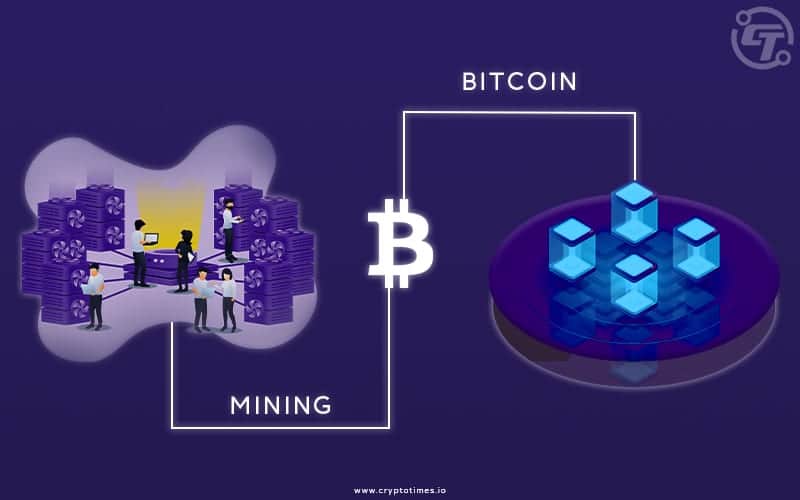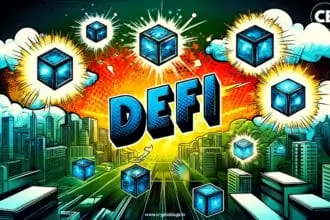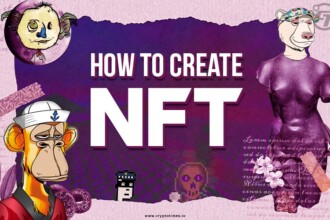Bitcoin or BTC is a decentralised digital money that is sent from one to another user without any intermediaries. There is no single administrator or central bank. Bitcoins are created as a result of the mining process. Bitcoin mining is a key aspect of the bitcoin blockchain
Although the coins can be exchanged for other currencies, products, and services, their real-world value is extremely volatile. However, over time Bitcoin has shown great potential. Some may argue it to be the best investment opportunity of this century.
Bitcoin is divided into smaller units known as “satoshis” and used for payments. It is also utilised as a store of value, comparable to gold.
What is Bitcoin Mining?
Bitcoin mining is a key element of the blockchain ledger’s upkeep and development. It is also BRINGS new bitcoins into circulation. It is carried out with the assistance of highly advanced computers that answer incredibly difficult computational math problems.
Bitcoin miners are paid in Bitcoin for completing “blocks” of validated transactions and adding them to the blockchain. Because miners are paid for their efforts with cryptocurrency tokens, mining has a magnetic appeal for many cryptocurrency investors.
To set up a mining setup, one will need a GPU (graphics processing unit) or an ASIC (application-specific integrated circuit).
How does a bitcoin transaction take place?
On the blockchain, a transaction is a transfer of Bitcoin value. In the most basic terms, a transaction occurs when participant A transfers a specific quantity of Bitcoin to participant B. This method is known as the UTXO method.
To secure the integrity of transactions created on the network, Bitcoin employs public-key cryptography. Each participant has a pair of public and private keys that control the amount of bitcoin they own.
A transaction mainly comprises three aspects at a high level. This could be explained by this particular example where Amber sends .05 bitcoin to Brian.
a) Inputs: The bitcoin address where Amber wishes to send the bitcoin. To be more precise, it’s the address where Amber previously received bitcoin and now wishes to spend it.
b) Outputs: Brian’s public key, also known as his bitcoin address.
c) Amounts: The number of bitcoins Amber wishes to transfer.
By changing the fee rate, Bitcoin users can determine how soon their transactions are processed. The sooner the transaction is handled, the greater the charge rate.
What do Bitcoin Miners do?
Auditor miners are compensated for their efforts. They are in charge of ensuring that Bitcoin transactions are legitimate. Miners help to prevent the “double-spending problem” by confirming transactions.
Double spending is a scenario in which a Bitcoin owner spends the same bitcoin twice. As Bitcoin follows the UTXO method, Miners already know the amount of bitcoins possessed by a wallet. A miner had verified the transaction of those bitcoins sent to that wallet. As every miner has access to the ledger. No one can double spend their bitcoins.
To incentivise the miner’s Satoshi introduced Block Rewards, however, to keep the miners from quickly obtaining all the bitcoins he had put a size limit on the blocks. Satoshi Nakamoto imposed the 1 MB limit, which has caused debate, saying that block size should be increased to accommodate more data.
1MB of transactions can be as few as one to as many as several thousand. It all depends on how much data is utilised by the transactions.
Mining has another important purpose besides filling miners’ pockets that it’s the only way to release fresh bitcoin into circulation. To put it another way, miners are essentially “minting” currency.
Bitcoin Mining in Future :
The last bitcoin will not be distributed until roughly 2140, as the rate at which bitcoin is “mined” is diminishing gradually. After mining the last bitcoin, miners will only earn the transaction fees from their blocks.
When bitcoin was originally mined in 2009, the Block reward for one block was 50 bitcoins. This was reduced to 25 BTC in 2012. By 2016, it had been cut in half again, at 12.5 BTC. The payout was reduced again on May 11, 2020, to 6.25 BTC.
What is a bitcoin node and how does it work?
Bitcoin node is a storage device that can store the Bitcoin blockchain, such as a laptop or PC with internet connectivity. These nodes provide as a link between miners and users. On their servers, they also keep the Bitcoin blockchain.
Each node is in sync with the others. Even if a node is disconnected, once it reconnects, it will download the most recent data from the other nodes.
Consider it as a Google Sheet with View-Only permissions. One can view the sheet at any time when they’re online if they have access. Any changes made by other people with edit access while they’re offline will be seen once online.
Using a Bitcoin node to create transactions further boosts security by reducing or eliminating the need to disclose private keys. Users of Bitcoin Core can construct an unsigned transaction known as a Partially Signed Bitcoin Transaction (PSBT).
Consensus and PoW in bitcoin:
Approaches that are used to obtain agreement, trust, and security across a decentralised computer network is known as a consensus mechanism.
Proof-of-Work (PoW) is the consensus process used in the Bitcoin blockchain that uses computing power to solve a challenging problem. PoW is a widely used consensus technique in cryptocurrency networks such as Bitcoin and Litecoin. The entire bitcoin mining mechanism consumes a lot of energy and takes a long time to process.
Proof of stake (PoS) is another popular consensus technique that is an alternative to the proof of work (PoW) process. However, this has the drawback of encouraging hoarding rather than consumption of cryptocoins.
While PoW and PoS are by far the most prevalent in the blockchain space, there are other consensus algorithms like Proof of Capacity (PoC), Proof of Activity (PoA), Proof of Burn (PoB), Proof of Elapsed Time (PoET).
What is a block?
Blocks are files that retain data connected to the Bitcoin network indefinitely. A block is made up of a list of some or most recent Bitcoin transactions that haven’t been recorded. As a result, a block is similar to a page in a ledger or record book.
When a block in the blockchain is ‘completed,’ it makes room for the next block on the chain. As a result, a block is the permanent storage of records that can’t be changed or erased once recorded.
The ‘present’ is represented by a block, which contains information about the past and future. When a block is finished, it becomes a part of the past and makes room for a new block.
The completed block is a permanent record of previous transactions, while the current block is where fresh transactions are recorded. As a result, the entire system runs in a loop, and the data is permanently retained.
What is a block reward and how are they awarded?
Block rewards are new bitcoins awarded to miners in exchange for solving a difficult math problem and creating a new block.
The miners use computer networks to achieve this, and each new block is validated by all of the other competing miners. After that, the miners are given a new math problem to complete, and the process starts over.
Block rewards are also used by Ethereum, bitcoin’s major cryptocurrency competitor, to offer incentives to miners. The reward in Ethereum is known as “ether,” and is awarded to miners who successfully provide the mathematical proof of a new block.
Satoshi Nakamoto, the creator of bitcoin, planned it to have just 21 million bitcoins in total to limit inflation. This is why, after every 210,000 blocks, which takes about four years, the size of bitcoin block rewards is halved.
What is halving? How is it related to Bitcoin mining
When the reward for mining bitcoin transactions is cut in half, it is known as a Bitcoin halving event. This event occurs every 4 years.
Any miner who is able to verify one block of transactions and add it to the bitcoin network is compensated with bitcoins as a reward. It takes 10 minutes to complete a Block. Miners currently receive 6.25 BTC for each valid block they mine. However, the incentive changes every four years or so.
There have been three bitcoin halving occurrences to date, the most recent being on May 11, 2020. Notably, every halving results in a shift in the price of bitcoin.
Here’s how it works:
When bitcoin was originally established in 2009, miners were paid 50 bitcoins per block processed. The reward was cut to 25 BTC after the initial halving, then to 12.5 BTC, and eventually to 6.25 BTC.
Bitcoin’s inflation rate is also reduced by halves. Inflation is the loss of purchasing power for anything (here it’s about currency). However, bitcoin’s basic infrastructure is designed to be a deflationary asset. In order to achieve this, halving is critical.
What is hash in cryptocurrency?
The process of having an input item of any length mirror an output item of a defined length is referred to as hashing in the blockchain. For example, the use of blockchain in cryptocurrencies, where transactions of variable lengths are passed through a certain hashing algorithm.
This is true regardless of the length of the input transaction. A hash is a name given to the result. A notable example is the Secure Hashing Algorithm 256 (SHA-256) used in Bitcoin.
Hashing using SHA-256 always gives an output result of a fixed length, which has a 256-bits length. The hash size is defined by the hash function used, but a certain hashing technique’s output will be of a specific size.
What is confirmation time in bitcoin?
When a Bitcoin transaction’s block is uploaded to the blockchain, it is considered confirmed. The transaction is confirmed every time a new block is added to the chain. The more blocks added, the more certain an irreversible transaction is, and each block takes about 10 minutes to complete.
Six confirmations are often desired for large transactions, which can take an hour. Hundreds of confirmations and hours of waiting may be necessary for multi-million-dollar transactions.
What are the difficulties faced in bitcoin?
Challenges faced by bitcoin are:
a) Many organisations have begun to accept Bitcoins; however, it is surprising to find that the internet giants still refuse it.
b) The largest issue that the bitcoin network faces is how long it takes for the system to execute bitcoin transactions. The average time it takes to verify a bitcoin transaction is roughly 43 minutes.
c) The transaction cost fee is applied to bitcoin transactions, resulting in a pending line of transactions. People are migrating to other ways or currencies to execute transactions fast and easily as a result of this problem.
d) Another significant issue for bitcoin users is the lack of anonymity. In actuality, bitcoin transactions are hashed rather than encrypted, allowing for analysis and public monitoring of all transactions.
Conclusion:
Despite the fact that many people sought bitcoin currency to escape government regulation, the high prevalence of illegal behaviour. The bitcoin network works on itself using the mining process.
In the last two years, the US government has recognised Bitcoin as a kind of property and begun to regulate it. The government seeks to deter illicit conduct by registering enterprises that use Bitcoins.







